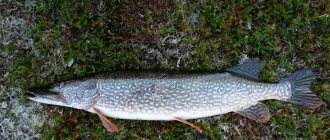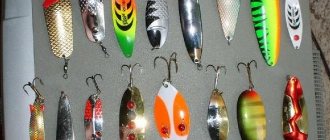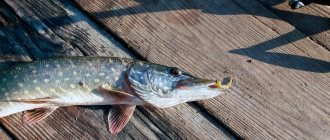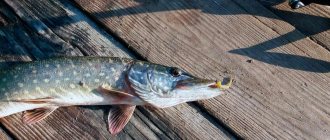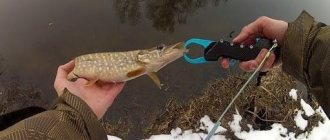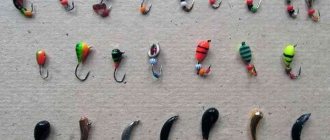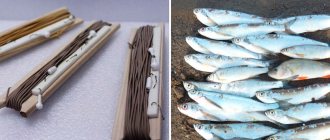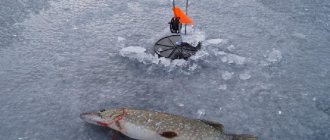DIY fishing mugs
One of the fishing gear for catching predatory fish is mugs.
Since up to 10 circles are used for fishing, it makes sense to make them yourself. Currently, fishermen have a wide selection of gear for catching predators. In recent years, new methods of fishing have appeared, and manufacturers have created many artificial baits. However, pike, pike perch or perch often refuse the most plausible fish imitations, preferring live bait. At such moments, it turns out that fishing with mugs looks preferable to spinning or trolling.
The circle was invented quite a long time ago; even in Soviet times, attractively colored gear was available for sale. However, fishermen are not always satisfied with the quality of industrial products.
In this case, ingenuity and skillful hands come to the rescue. As an example, consider several homemade products that successfully cope with catching predatory fish.
Square tackle made of polystyrene foam
An interesting tackle with a square base can be made from scrap materials.
It has a small windage, is characterized by the absence of idle bites and allows you to adjust the force for turning over. Mugs are a very effective way of fishing, however, if you have a boat. Fishing will require a lot of physical strength. But homemade gear will clearly indicate a bite, and the trophy catch, after calm fishing, will be on board the boat. Video about catching predators with mugs:
Video on how to install mugs on water:
Source
DIY pike circle
Mugs are floating tackle for catching predatory fish (pike, pike perch, perch) with live bait. This tackle is very catchy both in terms of quantity and quality of fish caught.
The most widespread among fishermen are mugs in the form of a foam plastic disc, although mugs can also be made from wood, a plastic bottle, or a tin can.
Homemade circle for pike
There are also such unique designs as mugs made from a plastic bottle or tin can. It’s hard to say which circle is better; it all depends on the angler’s habits, conditions and fishing location.
Optimal sizes
As mentioned above, the optimal size of the circle is from 13 to 18 cm, but not everything is so simple here, it all depends on what kind of fish to catch and what size of live bait will be used. Also, the size of the mug depends on the material from which it is made. Mugs that are made from cork or foam are smaller in size than wooden ones and rarely exceed 13 cm in diameter.
If you are going to catch trophy specimens of pike, then the diameter of the circle should be within 18-20 cm. The thickness of the circle does not depend on the material and rarely exceeds 3 cm.
The process of making a tackle-mug with your own hands
To make a mug from wood, it is better to use a lathe; this will make the work much easier and the mug will have a neat appearance.
Materials for making a mug
Mugs made from lighter materials (cork, polystyrene) are easy to process, but at the same time they are quite fragile and will not last long. They also float excessively and in strong winds on a pond, it will be difficult for you to keep track of them.
Making mugs from wood is a more labor-intensive process, but the service life of such mugs, if processed correctly, will be longer. They are also a little heavier than foam or cork and won't blow around as easily.
Less traditional materials, such as a tin can or plastic bottle, can also be used to make mugs.
Making a mug
Let's consider the option of making a traditional pin circle from extruded polystyrene foam, it is also called penoplex, this material can be bought at any construction supermarket
The process of making mugs from wood is, in principle, no different from making mugs from foam plastic. It is better to cut a circle from linden; it is easy to process and has good buoyancy.
It is more convenient to cut and process the circle on a lathe. The wooden circle is subject to more careful processing. After sanding, the circle must be soaked in drying oil and puttied.
It is better to use a two-component putty based on tsapan varnish and BF2 glue. When the circle dries, it needs to be sanded again with sandpaper and painted. The paint can be used either nitro or oil based.
Equipment mug
The equipment includes the following elements:
fishing line
According to many fishermen, it is better to use a nylon thread with a thickness of about 2 mm on mugs. The thread or fishing line should have an inconspicuous color, usually green or brown. Also, this color will be clearly visible on the mug, which is very important, as it can inform the fisherman whether the cord is wound or not after a bite.
The thread is attached to the circle with an ordinary noose. The length of the cord should exceed the depth of the reservoir by 3-4 m; there is no need to leave a large margin, otherwise it may lead to tangling. If the depth of the reservoir turns out to be small, then you can limit the supply of the cord with a double loop.
Sinkers
Sinkers are used to hold live bait at a certain depth. The usual weight of the sinker is 10-15 grams, it is better when it has the shape of an olive. There is no need to secure the sinker tightly to the fishing line; it should slide freely; a stopper is installed at a height of 10-15 cm from the leash.
Leash
To protect the fishing line from the teeth of the pike, use a leash no longer than 30-35. Previously, steel leads were used, which were made from guitar string No. 1 or No. 2, but now new materials such as tungsten, titanium, etc., have appeared on sale.
But from personal experience and in the opinion of most fishermen, a fluorocarbon leash with a thickness of at least 0.6 mm gives a good result; if it is thinner, the pike can cut it off. cm. This material is flexible, it does not hinder the movement of live bait and is completely invisible in the water; you can also use nylon fishing line, but the result will be worse.
The leash is attached to the main line using a swivel with a carabiner so that it can be easily replaced. A clasp is attached to the end of the leash for quick replacement of the hook. You need to tie the carabiner and swivel using a clinch knot.
Hook
When catching pike with circles, both single, double and triple hooks are used; there is no consensus on which one is better, it all depends on the fishing technique.
If a fisherman has the opportunity to quickly approach like a triggered mug and hook in time, then you can use treble hooks, but if you fish by letting the pike swallow the bait, then double and single hooks are suitable, but the latter technique is used when fishing with girders.
The size of the hook is selected according to the size of the live bait; the larger the bait, the larger the hook. The most popular numbers for tees are 5-12 for single hooks 6-14. In practice, a method that has proven itself well is when two single hooks are used, one hook clings to the lip of the baitfish, the other is pierced under the dorsal fin, in its lower part.
Nozzle
Small fish - live bait - are used as bait. The best species of fish are those that inhabit the body of water in which you plan to fish. However, it is impossible to say unequivocally that pike will be caught with this particular bait, but we can say with confidence that in most cases it prefers it. When choosing live bait, the time of year also plays an important role; in the summer, pike prefers crucian carp, in the fall, roach and perch.
The main fish species used as live bait are:
If we take into account the survivability and preference of pike, then the best live bait are considered to be crucian carp and gudgeon; roach is also highly valued by the predator, but it quickly falls asleep and is poorly stored, and also tries to constantly float to the surface, which is what confuses the tackle.
Bleak is a more seasonal fish and very delicate, suitable for fishing in spring and autumn. Pike takes ruff or perch less readily, but in reservoirs where these fish species are the main food supply, it grabs them greedily.
Available materials
There are various models of pike tackle, which differ in design and materials. You can also use a free base that can be found in every home - a can of canned food or condensed milk. This non-standard option is quite convenient to use, it does not respond to bait jerks and holds perfectly on the water surface.
In order to make a fishing circle with your own hands, you need to drill holes with a diameter of no more than 5 mm in the lower and upper parts of the tin can. A wire is pulled through them and twisted on both sides in the form of a ring. It needs to be soldered for tight fixation, and this will also ensure sealing of the entire device. Next, the structure is covered with paint in contrasting shades, for example, white and red. One side equipped with a ring is painted in a brighter tone, the other should be less noticeable.
Two rings with a width within 1 cm are cut out of a bicycle inner tube and placed on the jar.
A nylon cord about 25 cm long is fixed on wire rings. It needs to be folded in half and tied so that a loop is formed, with the help of which the can will turn over during a bite.
A fishing thread about 5 mm thick, a large hook, a steel leader and a sliding sinker are attached to the loop as equipment. All devices are wound around the structure and secured to a rubber ring.
DIY mugs for pike from a bottle
This type of circles has not found wide application, but has the right to life.
Making such a circle will not be difficult; here is the procedure for preparing such a circle:
The mugs used for pike fishing must be the same size, especially in thickness. For ease of transportation and storage of mugs, the mast does not need to be tightly attached to the mug. And we must remember that the success of pike fishing depends on many factors, including knowledge of the reservoir, the ability to choose the right tackle and bait, as well as the personal qualities of the fisherman.
Source
Features of catching pike with mugs
According to real fishermen, mugs are the best way to catch pike. The advantage of this method is that you do not need to know exactly where these predatory fish are hiding. The circle, moving, itself discovers their location. Water flow and wind help with this. Therefore, catching pike with mugs is an ideal method. But this method is, of course, only suitable for summer fishing. In winter, of course, you won’t be able to cut through the surface of the water on a boat and ensure the movement of a circle with bait.
Which live bait is best for pike fishing
For catching pike with mugs, crucian carp is considered the best live bait. It's not difficult to catch him. It is found in almost all ponds and quarries; it bites actively, not disdaining most of the baits offered to it. The baited crucian carp behaves smartly, directing the circle in one direction or the other, thereby attracting the attention of the predator.
In general, almost any small fish is suitable as live bait, but sometimes you have to take into account the tastes of pike in a particular body of water. In some places it prefers roach and minnows, avoiding perches, in others it actively fishes for ruff. It also happens that it is not paradoxical. When biting is active, there are usually no special problems with live bait; you have to adjust if the pike starts to act up. Usually this is mid-summer.
It happens that the live bait is too large, and it is not possible to place it in the usual way, because every now and then it strives to turn the circle over. In this case, there is one trick: do not pass the line through the tip of the pin, but wrap it closer to the base. In this case, the leverage will be minimal, and it will be more difficult for large live bait to make a false bite. The predator will turn the circle over without any problems at the moment of its grab.
How to prepare for fishing using circles
Before fishing in this way, you need to conduct a study of the state of the bottom of the reservoir in which you are going to do this. For this purpose you will need a device such as an echo sounder. Although you can limit yourself to jig probing.
To drag caught fish into your boat, you will need a landing net and a hook. You can't do without reinforced gloves , because if you decide to do without this attribute, you risk cutting your hands on the sharp fins of the predatory fish you are going to hunt.
For fishing to be successful, you will have to stock up on live bait , since pike is a predator and will only bite on small, tasty fish. Suitable live bait include: rotan, roach, rudd, bream, crucian carp and gudgeon.
The fish that your pike will bite on will need to be kept in something during transportation and storage. To do this, you will need to use a canoe with a grate, thanks to which you will be able to remove the bait without putting your hands in the water.
You can use not only live fish as bait , but also dead ones . Just for the pike to bite on it, you need to cut its sides. Blood will flow out through the cuts and thus the dead fish will attract your potential prey.
In addition to all of the above, you will need leashes with hooks in reserve and an extractor with which you will remove hooks from caught prey.
Foam products
The modern assortment of various materials for the independent manufacture of devices opens up extensive possibilities, while their cost is affordable for everyone. The simple design of the device allows the use of bases with different porosities and thicknesses. A 150 mm foam plastic fishing circle is one of the most popular options; material with a thickness of 2 cm and a fine-porous structure is suitable for its creation. A metal-plastic tube can act as a pin, the optimal diameter is 15 mm.
What does a fishing circle consist of?
Equipment for pike fishing circles:
The pike fishing circle is made of durable material. Wood is best suited for its manufacture. Many people use foam plastic to equip mugs; it is light and does not get wet, but wood becomes heavier over time due to frequent exposure to water.
Typically, a fishing circle is a disk, the thickness of which is no more than 3 centimeters, and the diameter should be five times the thickness. You need to make a groove on the mug for the fishing line. The circle should also have slots in order to fix it on the fishing line and a hole where the pin will be inserted.
The fishing circle is usually painted. Its upper part is red, and the lower part is covered with white.
The pin for stringing bait has a thickening at the bottom, this is done so that the bait does not fall off it. The height of the pin must be adjustable. It must be adjusted to the weight of the bait and the wind.
It is better to use a monofilament line for fishing rather than braided one. Wicker can seriously cut your hands while you drag your catch. You can use cord instead of fishing line. You need to stock up on extra fishing line. Take at least fifteen meters with you. It is better to choose a fishing line thickness no thinner than 0.3 millimeters and no thinner than 0.5 millimeters.
If the reservoir in which we will fish is deep, then, among other things, you will need a sinker and a piece of rubber. The recommended sinker weight is 15 grams. If there is a strong current in the reservoir, then it is necessary to attach live bait to the tee by two lips . If the current is small, then it will be enough to pick it up by the gills.
What is a “circle” tackle and how is it designed?
The fishing circle is distinguished by the simplicity of its design, but at the same time it shows quite good results when catching such a predator as pike. By its principle, the tackle resembles a pier, which can be lowered from a boat and directed either with the wind or with the current.
The gear is completely independent, so the fisherman only needs to closely observe the vibrations of the circle, in the center of which there is a kind of float, and when biting, pull the fishing line or thread sharply and in time in order to catch the predator.
Description and device
A circle, or, as fishermen also call it, a floating girder, is a circle that is about 15–20 centimeters in diameter. The thickness of the device ranges from 20 to 25 millimeters.
In the center of the circle there is a special recess on which a certain amount of fishing line is wound, and at the very top there is a slot for securing the tackle in one position and attaching it to the sinker.
The tackle itself consists of several separate parts:
- A circle in which the upper part is painted red or any other bright color, and the lower part is necessarily white.
- A mast that is installed in the central hole of the structure in such a way that the large rounded part remains at the bottom, and a thin mast with a slot for attaching a fishing line is located at the very top.
- Lines of a certain diameter.
- Hooks that every fisherman selects depending on the size of pike he wants to catch;
- A leash that takes fish with sharp teeth away from the tackle itself, thereby protecting it from premature wear.
The most simple design allows fishermen to get a very solid catch, which they are not ashamed to show off.
Making a mug for pike with your own hands
At the next stage of work, you need to make a groove on the end side of the future circle. Its depth should be 1 centimeter. To make our groove smooth, we will process it with sandpaper. We make a hole in the center of the circle. Its diameter is from 6 to 8 millimeters.
You need to make two slits on the top of the circle. They are needed to secure the fishing line.
Now you need to make a pin . It is made from a wooden plank. It is ground down so that its shape eventually becomes cone-shaped. Naturally, you need to make a groove at the end so that there is something to cling to the fishing line. Next, the disk and pin need to be painted. The upper part of the disk is red, the lower part is white. And the pin is painted exactly the opposite - the bottom is red, the top is white.
The next step is to wind the cord around the circle . Its length should be at least 10 meters, but more than 15 meters, in general, is also useless. A metal leash is attached to the cord. There is a weight on the leash that must be movable. All that remains is to tie the hook, and our homemade tackle is ready.
By the way, the shape of your gear can be not only round. There are also non-standard devices. For example, a square mug. The principle of its manufacture is slightly different from what was described above. Only instead of a disk, a square is cut out. Well, to thread the fishing line, a reel is attached to the square using self-tapping screws. The square itself is left white, and the coil is painted red.
What are the advantages of a square fixture? It is less prone to windage, so false bites are excluded. Plus, you can adjust the effort needed to turn this gear over. If you fulfill all these conditions, then you will get the correct circle.
The device of a fishing mug made of polystyrene foam
A foam nickel with a high-quality treated surface is the basis of the device. Greater accuracy in manufacturing can be achieved using a regular CD or cardboard template. An electric jigsaw or construction knife is suitable for cutting the material.
Particular care is required when cutting a groove, which should be located along the entire circumference and have a depth of within 1 cm. To create it, you can use a round file or knife. A drill with a drill diameter suitable for the size of the tube is needed to make the central hole.
Using fine-grained sandpaper, the surface of the disc is processed, then it is coated with a coloring compound. Contrasting shades should be used to color the bottom and top to ensure visibility even from a great distance.
Then you need to make two cuts for the fishing line on the upper plane of the device. They should be located on both sides of the circle, opposite to each other.
A part 12 cm long is cut from the metal-plastic tube, and notches are cut from the end side of it.
Many beginners have a question: how to equip a fishing circle? There is no definite answer here, since it all depends on the surrounding conditions and the preferences of the fisherman. The best option would be an addition in the form of a metal leash with a tee, a lead weight weighing about 10 g and a fishing thread at least 100 cm long.
Installation of circles
So, you have made your gear and chosen a place where you will catch pike. Now you need to install fishing mugs .
Each angler is allowed to have a maximum of five fishing gear. If you fish with someone else in the same boat, you can use 10 tackles.
Take the circle and wind the cord from it. The length should be such that the bait is at a depth of half a meter to one and a half meters from the bottom. Now we attach a small float made of cork to the end. We insert the cord into special cuts on the outside of the circles. Wrap the cord around the pin a couple of times. We attach bait and lower this structure into the water. The distance between circles should be from 5 to 10 meters. You need to monitor the tackle from a distance so as not to spook the fish, and, at the same time, not to lose sight of the mugs. It's best to just have them follow the boat.
If the current is strong, then it is better to anchor the tackle , otherwise they will simply be carried away. A fishing line is used as anchors, which is tied with one ring to a pin, and the other to thickets and bushes. If there are no thickets, then they take a stick and tie a cord weighted with a weight to it, and the other end of the stick is attached to the thickest part of the pin.
If a pike pecks at your bait, the circle first turns over with its white side up, and then rotates, and the fishing line unwinds. When the movements stop, it means the fish has taken the bait. After which the circle begins to rotate again, which means that the pike is trying to go into cover. At this moment you need to drag it into the boat, pulling up the fishing line, and help yourself with the hook.
When fishing with mugs, you need to carefully monitor each tackle . While you are hooking or dragging one fish into the boat, the rest of the gear can become tangled. It is important to ensure that this does not happen.
After you have finished fishing, you need to carefully collect all the mugs, remove them from the water and wind the cords across them. The tackle is stored in disassembled form. The pins are detached from the circles and stored separately. Sometimes, after you have caught enough fish in one place, you have to change your fishing spot. Summarize. For your pike hunt using mugs to be successful, you need to:
How not to miss the moment
It is enough to place the devices and watch them while waiting for a bite. You can tell when a predator has been caught by turning them over. It is worth noting some features of fishing with this method:
- the fishing tackle circle turns over if the pike catches the bait;
- if it starts to spin, this indicates that the predator is leaving with the bait;
- when the fish begins to swallow prey, the device will freeze in one place.
The pike must be hooked while the circle is moving after a short lull. It is important not to miss the moment so that the aquatic inhabitant does not have time to hide at the bottom. Catching this type of fish is similar to sports competitions, in which those who are able to make timely decisions, have endurance and quick reactions win. Obtaining a trophy is only possible if you follow the right tactics.
Useful tips
There are many ways to increase your catch . Some of them are more effective, some less. Let's talk about the most effective ones. To increase the bite you can:
What is an activator ? This is an additive that is applied to the bait and attracts fish with its smell. The activator is effective in both warm and cold water. The most popular additive is “Hungry Fish”.
Pheromones are a bait based on, as you, of course, guessed it, pheromones.
What does proper equipment mean? This means that for each type of fish - predatory, non-predatory, large, small, etc.
a certain type of gear is used. For example, in order for you to have a good catch of pike, it is best to organize mug fishing. If you hunt some other fish, then the type of gear changes. Information on each type of gear can be easily found on special websites. The choice of fishing location is also important, since different types of fish prefer different places.
Some people like to live on wide stretches, others - at great depths, and others - among snags and holes. For example, during the spawning period in the spring, pike is at shallow depths, in the summer it moves to places where there are many holes, reeds and bushes, and in the fall it lives among snags. If you see small fish periodically jumping out of the water, then most likely there are pikes here. If you catch a predator with mugs, it is better to choose a reservoir with many water lilies, so it will mistake your tackle for leaves. Pike is best caught in the fall; during this period it becomes the most voracious. Source
